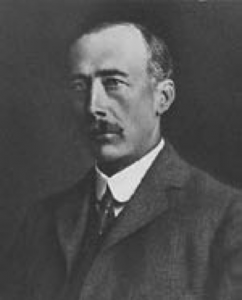The longest serving Professor and Head of the Department of Geology at Bristol, and great promoter of geological education.
Professor Sidney Reynolds DSc, FGS (1867-1949) was born in Brighton and educated at Marlborough College and University College, Cambridge, where he studied natural science and, under the influence of T. McKenny Hughes and J. E. Marr, began to specialise in geology. His first professional appointment was as acting professor of zoology at Madras Christian College, in 1892. In 1894, Reynolds was employed to help Lloyd Morgan with teaching.
His first post in Bristol was as Assistant Lecturer and Demonstrator in Biology, and this was to mark the beginning of a long career dedicated to the teaching of Geology and to the development of the department and its collections. By this time, the Department of Geology and Zoology was already established in the main college building on University Road, where it shared a single lecture room with several other departments. Office space was at a premium, so Reynolds’ office doubled as a teaching laboratory and his work had to be moved whenever the table was required. The department’s collection of geological specimens occupied a single cabinet, and its library comprised only two shelves of zoology and geology books with no periodicals.
 In 1901, after Lloyd Morgan’s research interests in the field of experimental psychology and animal behaviour led to his appointment to a new chair in Psychology and Education at Bristol, Reynolds succeeded him in the Chair of Zoology and Geology. His duties included teaching what we now regard as geography, as well as geology and zoology; for a short while he also taught botany. Geology did not become a separate department until 1910, the year after the royal charter was granted for the creation of the University of Bristol.
In 1901, after Lloyd Morgan’s research interests in the field of experimental psychology and animal behaviour led to his appointment to a new chair in Psychology and Education at Bristol, Reynolds succeeded him in the Chair of Zoology and Geology. His duties included teaching what we now regard as geography, as well as geology and zoology; for a short while he also taught botany. Geology did not become a separate department until 1910, the year after the royal charter was granted for the creation of the University of Bristol.
The wide range of activities encompassed by his early posts in Bristol appealed to Reynolds, because he was fundamentally a naturalist with an interest in all field studies. His text-book on “The Vertebrate Skeleton” remained for many years a standard work for students of zoology, and later, following these interests, he wrote Volume 3 (1922-39) of the Palaeontographical Society’s monographs on the Pleistocene Mammalia, the first two volumes of which had been written by Boyd Dawkins in 1872 and 1878.
While Professor of Geology at Bristol, Reynolds’s focused mainly on field geology, covering a wide variety of topics. His early work dealt with the Lower Palaeozoic rocks of western Ireland, collaborating with C. I. Gardiner. He wrote many papers on the geology of the Bristol district, describing the Silurian rocks of the Mendips and the Carboniferous Limestone of many areas. He collaborated with Arthur Vaughan (1868-1915), a fellow student with him at Trinity College, and employed until 1910 as tutor at the Territorial Army establishment in Clifton, Bristol, on some of the definitive works on Early Carboniferous stratigraphy of the Avon Gorge. Reynolds also wrote papers on the geological structure of parts of Somerset and Gloucestershire, often in collaboration with colleagues.
Reynolds made major contributions by broadening the teaching of geology, presenting courses not only to students during the week, but also offering classes on Saturdays for extension students. He collaborated widely on his research, using this as a means to train the younger generations. He also travelled widely and collected rocks and fossils both for teaching and in connection with his research, and his collections form the core of the current museum. He encouraged the teaching of geology at Clifton College and fostered the study of geology among amateurs through the geological section of the Bristol Naturalists’ Society, and his field guide to the Bristol district, first published in 1912.
Reynolds was president of Section G of the British Association in 1926. He was awarded the Lyell Medal of the Geological Society of London in 1928. He retired in 1933 as professor emeritus, and then become curator of the Stroud District Cowle Museum. In an obituary in Nature, Reynolds’ successor, Arthur Trueman, wrote, “Always modest and unassuming, charitable in his judgments and warm in his appreciation, Reynolds made many friends and lost none. He will be remembered with gratitude and affection by many besides his own students”.
Read more
Reynolds, S.H. 1897. The Vertebrate Skeleton. Cambridge University Press. Online version here.
Reynolds, S.H. 1912. A Geological Excursion Handbook for the Bristol District. J.W. Arrowsmith, Bristol.
Trueman, A.E. 1949. Prof. S. H. Reynolds. Nature 164, 473–474. Online version here.

